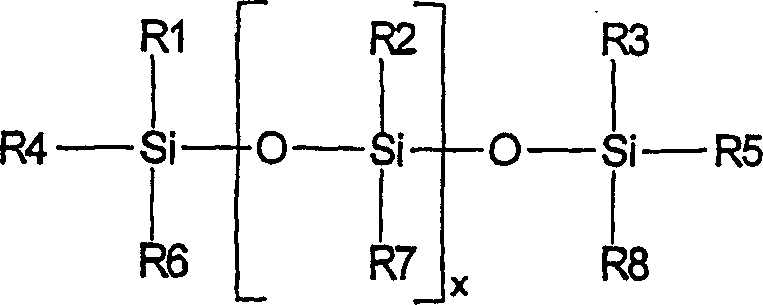Organosilicon water repellent compositions
A technology of polymers and copolymers, applied in other chemical processes, coatings, chemical instruments and methods, etc., which can solve problems such as lack of teaching
- Summary
- Abstract
- Description
- Claims
- Application Information
AI Technical Summary
Problems solved by technology
Method used
Image
Examples
Embodiment 1
[0068] Example 1 - Solvent Based Composition
[0069] A mixture was prepared containing polymethylhydrogensiloxane, silicone resin and alkoxysilane n-octyltriethoxysilane in a ratio of 8:1:1. The mixture was diluted to 20% solids in KWIK-DRY(R) 66 aliphatic dry cleaning solvent and the composition was applied to lightweight concrete bricks. Use this 20% solids mixture in accordance with ASTM Test Method E-514 to achieve a coverage of 55 sq. ft. per gallon. The properties of the composition were determined according to the NCHRP 21-day drainage test by immersing the test cube in water for 30 seconds. The properties of the compositions under these conditions are listed in Table 1.
[0070] The polymethylhydrogensiloxanes used in this and subsequent examples have a silicon-bonded hydrogen content of 1.4-1.75% by weight and a viscosity of 20-40 centistokes (mm 2 / sec) of trimethylsiloxy-terminated polymethylhydrogensiloxane.
[0071] The silicone resin used in this example an...
Embodiment 2
[0072] Example 2 - Composition in Emulsion Form
[0073]Using the emulsification method described above, an emulsion was prepared with polymethylhydrogensiloxane, silicone resin, and the alkoxysilane n-octyltriethoxysilane. These three silicone components were mixed in a weight ratio of 8:1:1. Using 40 parts by weight of these three silicone components, 13.3 parts by weight of octamethylcyclotetrasiloxane as a volatile methylsiloxane, and 0.6 parts by weight of SPAN20 nonionic surfactant with an HLB value of 8.6 Agent, the ARALTONE T nonionic surfactant with the HLB value of 1.0 parts by weight of 9.0, the G-4280 nonionic surfactant with the HLB value of 1.4 parts by weight of 19.1, that is, PEG-80 sorbitan laurate, 0.8 parts by weight of the freeze-thaw additive ethylene glycol and 42.9 parts by weight of water to prepare the emulsion. The properties of the emulsion composition are shown in Table 1 when the emulsion was diluted to a 1:1 ratio with more water and applied t...
Embodiment 3-
[0074] Example 3 - Another composition in the form of an emulsion
[0075] Except for the addition of 2.2 parts by weight of cationic amino-functional polydimethylsiloxane containing reactive silanol functional groups stabilized by cationic and nonionic surfactants to the diluted emulsion of Example 2. Apart from the emulsion, a second emulsion was prepared according to the method used in Example 2. The properties of the emulsion composition are shown in Table 1.
[0076] Embodiment 4-comparative example
[0077] A solution containing 20% by weight n-octyltriethoxysilane was prepared in isopropanol using a titanate catalyst. The composition is applied to lightweight concrete blocks. This composition was used in accordance with ASTM Test Method E-514 to achieve a coverage of 55 square feet per gallon. The properties of the composition were determined according to the NCHRP 21-day drainage test method by immersing the test cube in water for 30 seconds. The properties ...
PUM
| Property | Measurement | Unit |
|---|---|---|
| number average molecular weight | aaaaa | aaaaa |
| boiling point | aaaaa | aaaaa |
| boiling point | aaaaa | aaaaa |
Abstract
Description
Claims
Application Information
 Login to View More
Login to View More - R&D
- Intellectual Property
- Life Sciences
- Materials
- Tech Scout
- Unparalleled Data Quality
- Higher Quality Content
- 60% Fewer Hallucinations
Browse by: Latest US Patents, China's latest patents, Technical Efficacy Thesaurus, Application Domain, Technology Topic, Popular Technical Reports.
© 2025 PatSnap. All rights reserved.Legal|Privacy policy|Modern Slavery Act Transparency Statement|Sitemap|About US| Contact US: help@patsnap.com



